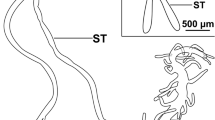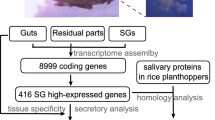Summary
The secretory proteins of the larval salivary gland of some Chironomus species were analysed according to a method developed by Grossbach (1969). After reduction of the disulphide bonds and alkylation the secretion of Chironomus thummi was separated by disc electrophoresis at acrylamide concentrations of 4.8 to 9.5% into seven main and some minor fractions. By increasing the acrylamide concentration up to 20% nine main fractions could be resolved. In addition to these high molecular weight structural proteins a number of proteins soluble in simple buffer solutions and separable at pH 8.8 in a 15% acrylamide gel are present in the secretion but only to a very small amount.
The electrophoretic pattern of the secretory proteins of Chironomus strenzkei, Ch. luridus and Ch. obtusidens are qualitatively the same as the Ch. thummi pattern. Some quantitative differences may exist. In the secretion of Chironomus plumosus at least eleven main fractions were detected in 20% acrylamide gels. A comparison between the number of Balbiani rings of the salivary gland chromosomes and the number of main protein fractions in the salivary gland secretion yielded no direct correlation.
The results are discussed in respect to the question wether the major puffs of the gland, the Balbiani rings, encode the major products of the gland, the secretory proteins.
Similar content being viewed by others
Abbreviations
- BR:
-
Balbiani ring
- bis:
-
N,N′-Methylenebisacrylamide
References
Baudisch, W., Panitz, R.: Kontrolle eines biochemischen Merkmals in den Speicheldrüsen von Acricotopus lucidus durch einen Balbiani-Ring. Exp. Cell Res. 49, 470–476 (1968).
Bauer, H.: Chromosomenstruktur und-funktion. Jb. Max-Planck-Ges. 1957, S. 23–39.
Beermann, W.: Cytologische Analyse eines Camptochironomus-Artbastards. I. Kreuzungsergebnisse und die Evolution des Karyotypus. Chromosoma (Berl.) 7, 198–259 (1955).
Beermann, W.: Ein Balbiani-Ring als Locus einer Speicheldrüsenmutation. Chromosoma (Berl.) 12, 1–25 (1961).
—: Riesenchromosomen. Protoplasmatologia VI D. Wien: Springer 1962.
—: Operative Gliederung der Chromosomen. Naturwissenschaften 52, 365–375 (1965).
Beermann, W.: Gen-Regulation in Chromosomen höherer Organismen. Jb. Max-Planck-Ges. 1966, S. 69–87.
Berendes, H.: Salivary gland function and chromosomal puffing patterns in Drosophila hydei. Chromosoma (Berl.) 17, 35–77 (1965).
Buck, J. B.: Micromanipulation of salivary gland chromosomes. J. Hered. 33, 3–10 (1942).
Clever, U.: Chromosome activity and cell function in polytenic cells. II. The formation of secretion in the salivary glands of Chironomus. Exp. Cell Res. 55, 317–322 (1969).
— Storbeck, I., Romball, C. G.: Chromosome activity and cell function in polytenic cells. I. Protein synthesis at various stages of larval development. Exp. Cell Res. 55, 306–316 (1969).
Doyle, D., Laufer, H.: Analysis of secretory processes in dipteran salivary glands. In: Differentiation and defense mechanisms in lower organisms. In Vitro 3 93–103 (1968).
—: Sources of larval salivary gland secretion in the dipteran Chironomus tentans. J. Cell Biol. 40, 61–78 (1969a).
—: Requirements of ribonucleic acid synthesis for the formation of salivary gland specific proteins in larval Chironomus tentans. Exp. Cell Res. 57, 205–210 (1969b).
Fittkau, E. J.: Chironomus strenzkei n. sp. (Chironomidae, Dipt.), ein neues Laboratoriumstier. Z. Morph. Tiere 63, 239–250 (1968).
Grossbach, U.: Cell differentiation in the salivary glands of Camptochironomus tentans and C. pallidivittatus. Ann. Zool. Fenn. 5, 37–40 (1968).
—: Chromosomen-Aktivität und biochemische Zelldifferenzierung in den Speicheldrüsen von Camptochironomus. Chromosoma (Berl.) 28, 136–187 (1969).
Keyl, H.-G.: Die cytologische Diagnostik der Chironomiden. II. Diagnosen der Geschwisterarten Chironomus acidophilus n. sp. und Ch. uliginosus n. sp. Arch. Hydrobiol. 57, 187–195 (1960).
—: Chromosomenevolution bei Chironomus. II. Chromosomenumbauten und phylogenetische Beziehungen der Arten. Chromosoma (Berl.) 13, 464–514 (1962).
— Keyl, I.: Die cytologische Diagnostik der Chironomiden. I. Bestimmungstabelle für die Gattung Chironomus auf Grund der Speicheldrüsenchromosomen. Arch. Hydrobiol. 56, 43–57 (1959).
Laufer, H.: Developmental interactions in the dipteran salivary gland. Amer. Zoologist 8, 257–271 (1968).
Mechelke, F.: Das Wandern des Aktivitätsmaximums im BR4-Locus von Acricotopus lucidus als Modell für die Wirkungsweise eines komplexen Locus. Naturwissenschaften 48, 29 (1961).
Neuhoff, V.: Mikro-Disc-Elektrophorese von Hirnproteinen. Arzneimittel-Forsch. 18, 33–39 (1968).
Pelling, C.: Ribonukleinsäure-Synthese der Riesenchromosomen. Autoradiographische Untersuchungen an Chironomus tentans. Chromosoma (Berl.) 15, 71–122 (1964).
Slizynski, B. M.: Functional changes in polytene chromosomes of Drosophila melanogaster. Cytologia (Tokyo) 29, 330–336 (1964).
Weber, K., Osborn, M.: The reliability of molecular weight determinations by dodecyl sulfate-polyacrylamide gel electrophoresis. J. Biol. Chem. 244, 4406–4412 (1969).
Author information
Authors and Affiliations
Additional information
Communicated by C. Auerbach
Rights and permissions
About this article
Cite this article
Wobus, U., Panitz, R. & Serfling, E. Tissue specific gene activities and proteins in the Chironomus salivary gland. Molec. Gen. Genet. 107, 215–223 (1970). https://doi.org/10.1007/BF00268696
Received:
Issue Date:
DOI: https://doi.org/10.1007/BF00268696




